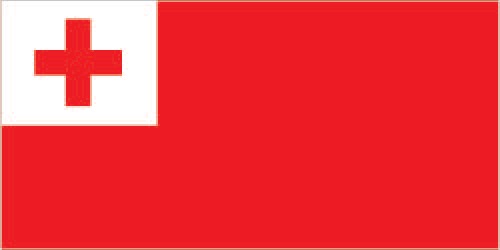
The Flag of the Kingdom of Tonga has undergone several changes throughout its history, reflecting the nation’s monarchy and historical developments.
Early Flags (19th Century):
Prior to European contact and the formal establishment of the Kingdom of Tonga, the islands had their own distinct tribal flags and symbols.
In the 19th century, as the monarchy was established and the Kingdom of Tonga took shape, flags began to be used as symbols of authority and identity.
First National Flag (c. 1862):
The first national flag of Tonga is believed to have been adopted around 1862 during the reign of King George Tupou I, who united the Tongan islands.
This flag featured a field of red with a white canton (a square at the upper-left corner of the flag).
In the canton, there were five red stars arranged in the form of a cross. These stars represented the islands of Tonga.
Colonial Period and British Protectorate (1900-1970):
In 1900, Tonga became a British protectorate while retaining its sovereignty and monarchy.
During this period, the Union Jack, the flag of the United Kingdom, was flown alongside the Tongan flag on official occasions and government buildings, symbolizing the protectorate status.
Post-Independence Flag (1970):
On June 4, 1970, Tonga gained full independence from the United Kingdom.
To mark this historic occasion, a new flag was adopted, known as the “Red Ensign of Tonga.”
This flag featured a red field with a white canton in the upper-left corner. Inside the canton was a simplified version of the Tongan coat of arms.
Current Flag (1985):
The current flag of Tonga was officially adopted on November 4, 1985.
It features a distinctive design, with a red field and a white canton occupying the upper-left quadrant.
Inside the canton is a red Greek cross with a white border, known as the “Taufa’ahau Tupou IV Cross.” It is named after King Taufa’ahau Tupou IV, who ruled Tonga at the time of the flag’s adoption.
The cross divides the canton into four equal parts, with each section containing a red quartered field with a white five-pointed star in the center.
The red color symbolizes the blood of Christ, and the white represents purity and Tonga’s aspiration to be free and Christian.
Significance and Symbolism:
The flag’s design holds deep cultural and Christian significance for Tonga.
The red cross is a symbol of Christianity and reflects the strong Christian faith of the Tongan people. The stars in the canton represent the Southern Cross constellation, which is a prominent feature of the night sky in the Southern Hemisphere and is associated with navigation and guidance.